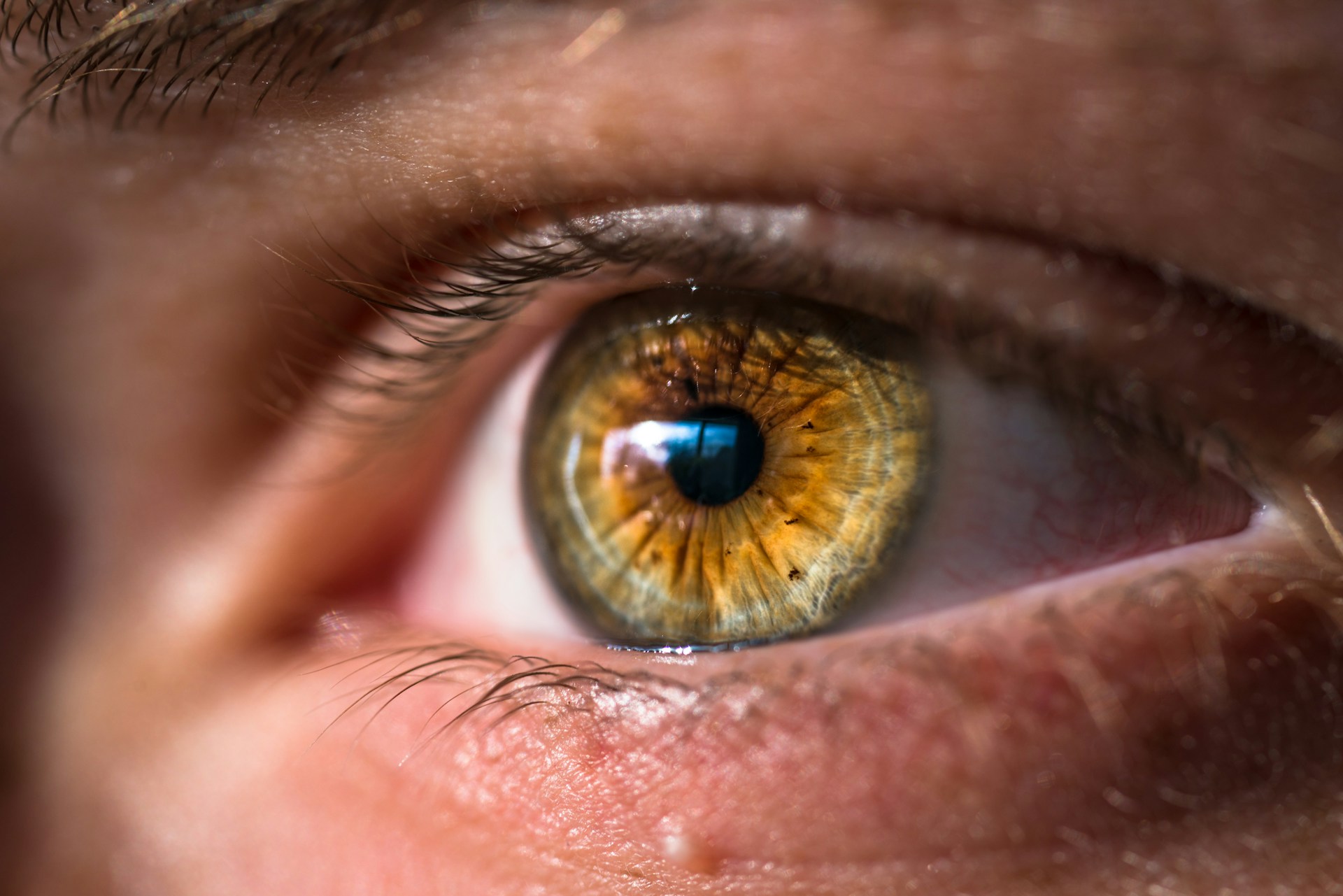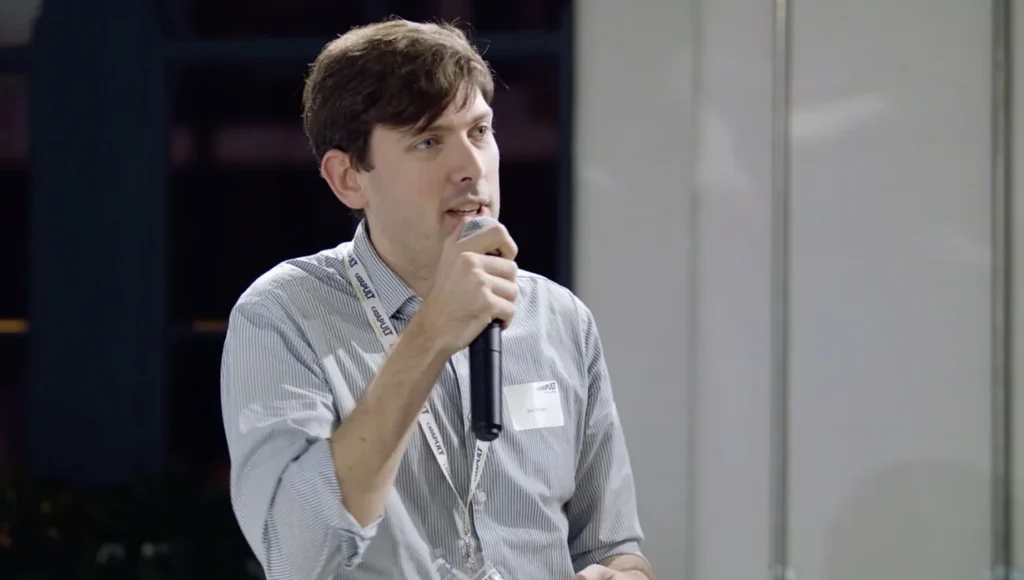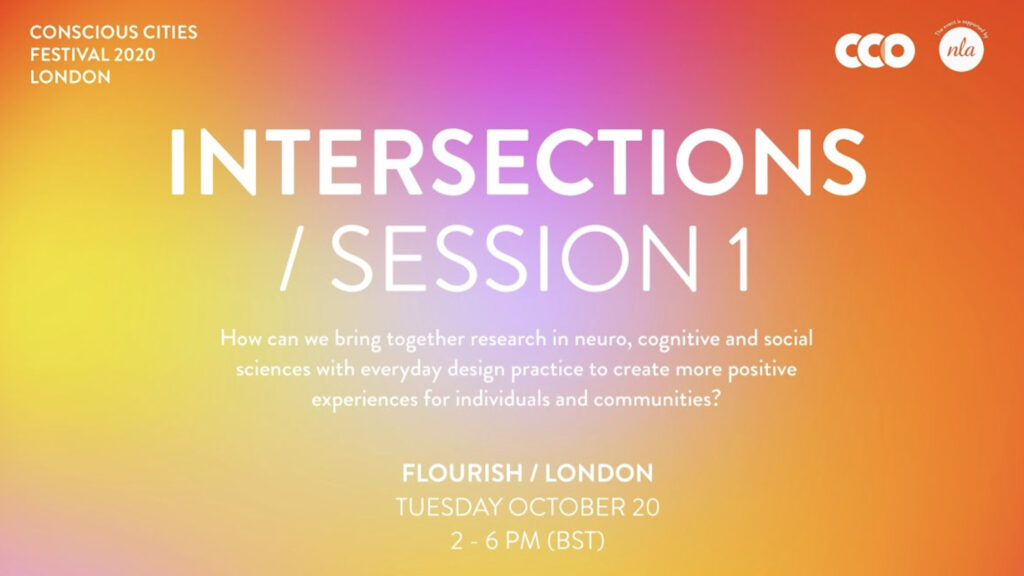Today’s progressive and fast anthropization and urbanization are significantly affecting the capacity of humans living in cities to be fully conscious of their wellbeing. This is happening not only because of ecological processes, but because we are losing our naturalistic intelligence, and the capacity to recognize what is good and what is not for us to thrive in a natural context.
Humans are very proud of their supremacy over other animals for their abilities in art, science and technology, and rely very much on the latter to decide what to eat, how to behave and how to build dwellings. Although science has the power to unveil the mystery of nature inside and outside ourselves, we find it challenging to lead a healthy life or to design and build healthy spaces to live in.
If we consider the progress we have made in understanding our biological relationship with just a natural element such as light, we find that it is enormous, but concurrently too complex to be translated into popular wisdom. We are losing our ancestral relationship with light, and many other natural phenomena around us.
The circadian biology revolution spurred by the discovery of the third photoreceptor requires us to re-consider our relationship with light. When electricity came into common use at the beginning of the last century, the field of lighting design emerged and developed. At the beginning, only the visual aspect of light was considered, later providing architectural qualities to enhance spaces or communicate emotions. These aspects have been interpreted as a consequence of architectural messaging, not as a direct effect of light on our neurophysiological system.
The third and newly discovered photo-receptor, bearing the scientific name IpRGCs (Intrinsically Photosensitive Retinal Ganglion Cells), is not involved in our visual process, but it is responsible of chronobiologic entrainment, namely the alignment of our biological clock to the environment in order to adapt to its changes on a stable phase of 24 hours.1
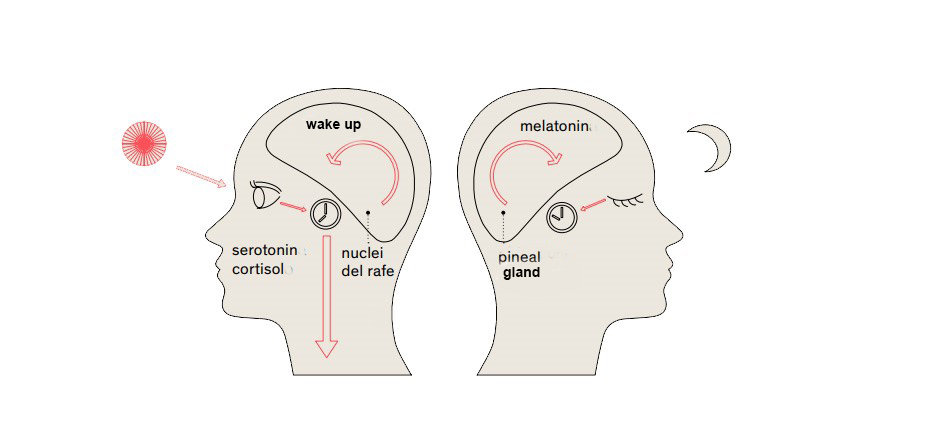
These cells make humans beings sensitive to light, but in particular of blue light, having the typical values of the daytime sky, whether it is a cloudy or sunny day, and ranging from values of 100 lux up to 20000 lux. They always work, even in the visually impaired and in those who are blind at birth. Their sensitivity varies according to the different qualities of light. Blue light is said to have a high circadian efficacy, that is the capacity to reduce the production of melatonin, and, therefore, of waking us up. This is a characteristic of the spectrum presenting high values of short electromagnetic waves (around the value of 470nm); values that record the photoreceptor’s maximum sensitivity.
It has taken considerable research effort to understand which parameters “switch on” the master circadian clock, altering the levels of melatonin in the blood. Not long ago it was thought that a very intense light of 2500 lux of neutral light had circadian efficacy, but today we know that the circadian regulation system is more nuanced. Our eyes are sensitive not only to different intensities, but also to specific parts of the light spectrum, to the duration of exposure and to the direction of light. Intensity, wavelength and color related temperature (CCT), direction, duration, timing, distribution and prior photic history are all factors that contribute to define the effectiveness of light in circadian entrainment.2
The advancement in knowledge of our physiological relationship with light means that artificial light should be considered as a communication tool, capable of suggesting healthy behavior, habituation, and creating awareness of our physical and mental needs.
For human cognition, there is an attentional disposition to perform differently depending on the specific phase of the day. Our capacity to focus is better in the morning than in the evening, for example. However, the poor quality of artificial lighting and often, poor architectural choices preventing exposure to natural light deprive us of the cognitive boost delivered by daylight.
A new approach to lighting design, called Human Centric Lighting (HCL) or Biodynamic Lighting is emerging. They require new designs and novel business models based on the knowledge that light affects us not only physiologically, but also psychologically.
The lighting industry is making progresses in proposing new products that respond to new codes and to new scientific requirements. Bulbs and systems should now be labeled with new specifications to facilitate design choices for healthier environments. Such simple measures can introduce significant improvements to how wellbeing is addressed in workplaces and schools. Offices that have joined quality building programs, have registered improved productivity and reductions of sick days, while pilot studies in schools are showing better control over mental impairments or disorders.3
However, the market is still far from implementing all the potential improvements to new products, as it is struggling to conciliate neurophysiological responses and visual acuity with energy efficiency issues. Producers are focusing on the technology of tunable lighting, providing adequate light in the respect of the circadian rhythm (blue light in the morning and warm light in the afternoon), but are not progressing on other aspects of our dynamic relationship with light.
The adoption by the lighting industry of high-technology such as sensors, microprocessors, and A.I. may have an important role in achieving more human-centric products, but their development must be informed by scientific insights from the biological, cognitive and behavioural sciences.
While we now know the relationship of circadian response to melatonin production, we do not know much about the production of other related proteins and hormones, although we know for sure that circadian misalignment has a very adverse effect on metabolic and hormonal factors, such as cortisol, prolactin, glucose and insulin, ghrelin and leptin. These are responsible for our alertness and mood, and are indirectly involved in the production of other hormones and neurotransmitters.4
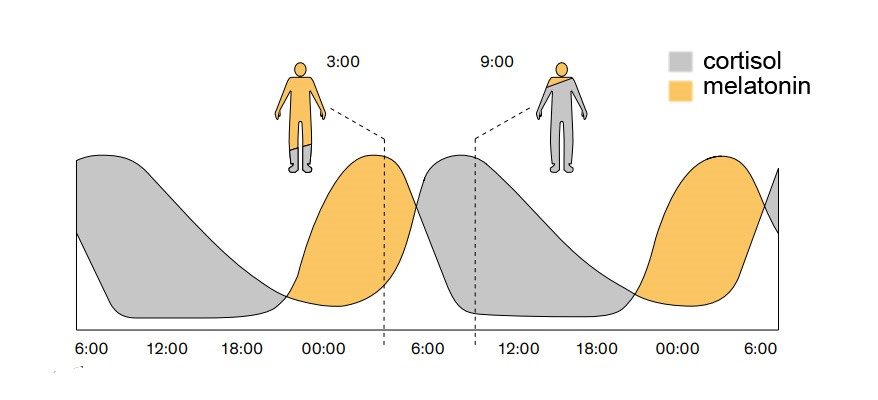
When it comes to factors affecting mental health, i.e., focus capability, good mood, good social predisposition, assertiveness, mindfulness, etc., it is clear that an aligned biological clock, ensuring a good sleep quality are essential.
Therefore, let us explore which are the environmental qualities (exogenous) which trigger or regulate the alignment of circadian rhythms, on which we can more easily intervene. There are many non-photic signals that can synchronize circadian clocks, such as exercise, melatonin, feeding and temperature, but light appears to be the most potent “time cue” to the master circadian oscillator. The activation of the “switch” for melatonin release depends on the detection of photosensitive ganglion cells (non-visual), but also from signals sent by rods and cones (the photoreceptors in the retina). We also know that the central nervous system receives light information via a secondary pathway whose existence has been identified, but its precise physiological relevance is yet to be determined5,6.
Given these findings, can we speculate that light somehow is responsible for short-term effects on our mental status, such as our ability to concentrate? We know that exposure to specific parameters of morning light wake us up, and alertness levels can increase because of suppression of melatonin secretion. A linear relationship has been found between alerting effects of light and activation in the posterior hypothalamus4.
The disruption of the circadian rhythm as a result of light exposure also produces changes in metabolism. The IpRGCs respond to light stimulus and they are present in the retina in a very small number compared to the “visual” rods and cones. However, what about other natural lighting conditions we experience everyday outside, that artificial light cannot replicate, and that we know are affecting our mood? We are referring to specific dynamic and ephemeral phenomenon like flashes, reflections, sudden changes in intensity, which are all manifestations of light in specific natural environmental and meteoric conditions.
Wilson coined the term Biophilia7 in his homonymous book to refer to the visceral connections that human beings feel with nature. It is not only about the relationship with greenery and animals. but includes every natural phenomenon that affect human senses. Not only views of trees, smell of flowers, fractal geometries, but also ephemeral aspects that affect our senses in more subtle ways. The importance of such biophilic factors is crucial under the view of different scientific disciplines such as neurophysiology, sociology, psychology, and it provides an interesting reference for research studies.
The anthropization of the environment of the last centuries has changed the relationship of humans with open spaces and in particular with the light of the sky. But this transformation involves a period of time of at most two or three millennia, compared to entire history of human presence on planet Earth. If we then consider how quickly the use of artificial light has become common, we can understand that this new experience has been too short to evaluate epigenetic effects or to expect adaptation.
Are there aspects of natural light that are neglected by artificial systems? Apart from high values related to blue light, occurring in the late morning sky (about 20000 lux), and the very low values of a night sky, which makes rods, responsible of our scotopic view, almost obsolete, there are aspects related to dynamism and transience. Natural light is never the same, and does not vary only with respect to the moments of the day and the direction of sunbeams, but it also varies according to weather conditions, to the orography of the place, the type of vegetation, and the type of anthropization. Natural light is an element that distinguishes a place from another, even if the recognition does not happen in full consciousness.
When people walk in the woods, they feel fully immersed in a diffused green light, but they are also exposed individually to games of reflections, different intensities, colors and directions that depend also on the wind, on the moment of the day and on a variety of interacting natural elements (i.e. vegetation, water mirrors, rocks, etc.). The more the stimuli are transitory and situations are specific, the more unique and memorable are the experiences related to them. The science on the interaction between light and humans is providing substantial results, but the lighting industry seems to be quite stuck on the production of tunable LEDs, and on playing with parameters like color temperature and intensity, without exploring all other light aspects affecting human neurophysiology. A more integral and physiological approach in lighting design is required in order to produce innovative solutions.
One such area of investigation on how light affects the human mind is the area its influence on cognition, especially concerning attentional capabilities that are so crucial to improve our level of perceived wellbeing in working environments.
Natural light regulating our biological clock is a dynamic process which varies mainly in the composition of its spectrum, in intensity and direction, but also in incremental modality and timing. Biodynamic Lighting (a new term is recently used in lieu of HCL) is an attempt to address these new biological aspects, although the market and all stakeholders involved are still missing some important considerations about what “biodynamic” really means and represents. Schemes claiming to be HCL have been little more than tunable-white installations, with much consideration for the control of physical aspects, but fundamentally ignoring or underestimating the importance of cognitive (as well as emotional and relational) aspects8.
In 2018, an Italian research team (which the authors are part of) investigated the potential of a smart lighting system, in support of people performing tasks requiring sustained attention. This form of attention is an important mental resource to be productive, which comes into play in many daily activities. It is important when people are solving problems that require more complex thought processes. As such, when sustained attention is weak or not well preserved, it can become a health threat by triggering stressful conditions to tasks.
In the study, we looked for the best lighting settings that balanced good visibility with psychophysiological factors, while simultaneously trying to induce healthy behavior taking into consideration the human limits and potentials related to sustained attention. The benefits were an improved performance in the short and the long term while respecting individual variations.
The lighting investigated in this project exploits a microprocessor to record individual and environmental data collected by sensors, and to set out the right light output according to a preset dynamic light. The light is adaptive and responsive to personal and environmental conditions, and tends to contrast the inevitable stress linked to focusing during a sustained attention task.
A prototype lamp, which was a simplified version of the project design was then used to validate the hypotheses in a behavioral experiment. The task consisted of a letter recognition task, in which participants had 30 minutes to recognize a random sequence of three letters as frequently and as fast as possible. All participants performed the task during the same time period of the day (in the morning) and low stress, as measured by a self-assessment questionnaires. The light dynamicity for the experimental group was expressed through increasing/decreasing values of color temperature and luminance, and a varying light cone, which induced a peripheral or central vision according to different parts of the task. In addition, we introduced emissions of instant flashes, which worked as ephemeral stimuli, which are known to induce a regenerative effect on attention. The figure below describes the light program used for the experiment:

The variability of CCT and intensity values, according to a specific moment of time varied within the limits found in consolidated scientific literature. The other two dynamic parameters, such as dynamic light distribution (light come) and the ephemeral stimuli (flashes), represent the novelty of the project lighting program.
To establish the variability of the experiment’s light conditions, timing and dosage for the experimental group followed a Gaussian curve (see Fig. 4), describing the general trend of our cognitive performance in the case of a focus task. This graph is a model based on current literature to describe the best efficiency for sustained attention. It shows how our stress, starting from being positive, and enabling good performance and productivity, then changes into negative when reaching the so called “breakpoint”. When our mental effort goes beyond the limit of high productivity we experience anxiety and start reducing the quality of the performance. The control group used a traditional suspended lamp for offices (a direct/indirect T5- 40W, CCT 4000k, CRI 80).
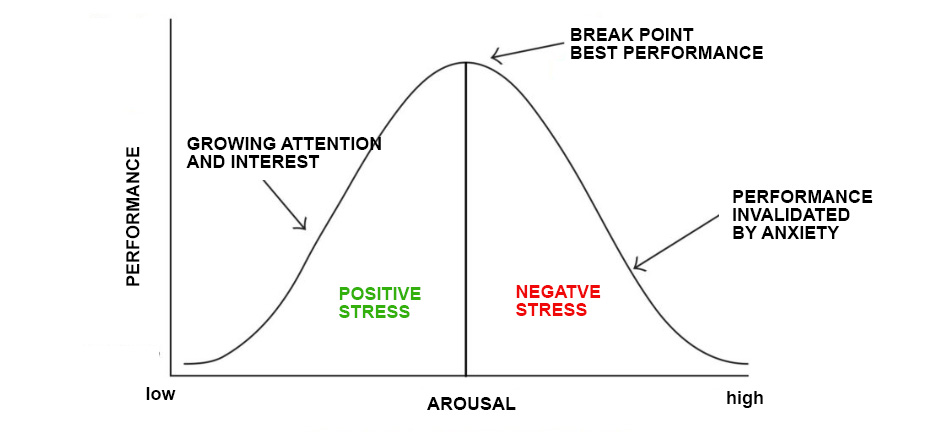
Sustained attention is a well-investigated research field in psychology and neuroscience, providing reliable tools for data evaluation and interpretation.
The amount of ATTENTION, calculated through the number of detected sequences decreased by the number of those missed is significantly greater in the experimental group. Also the ERRORS, that are the missed triplets, are significantly lower in the experimental group than in the control group.
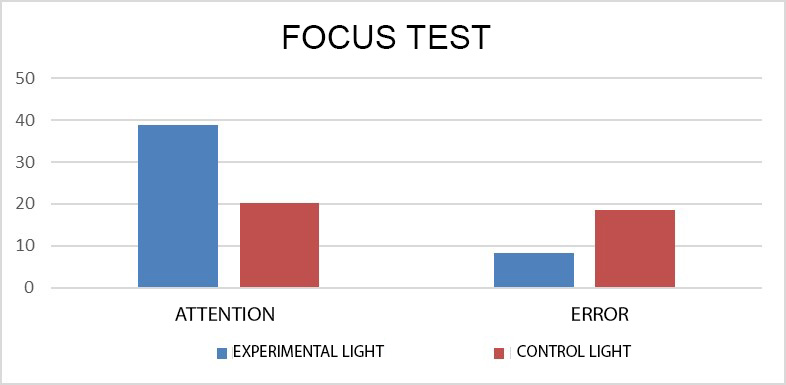
The results confirmed that the experimental group using the dynamic and proactive lighting registered significantly improved performance and an improved perceived well-being compared to the control group. Other remarkable results are that the experimental group perceived their light conditions as less confusing/distracting than the control group, and they judged the light conditions as more private and more confined than the control group (a semantic value known to increase the effectiveness on a focus task).
The introduction of flashes within the light cycle did not result in reported discomfort nor did it disturb results. Although glare is known to be an extreme form of non-uniformity and potentially debilitating, the proper control of timing and duration of more ephemeral artificial stimuli managed to replicate the positive effect of similar natural light phenomenon.
This research gives evidence that light plays an important role in creating spaces with a positive impact on occupants’ productivity and wellbeing. Additionally, the results of a final questionnaire revealed that most of the lighting variations were detected and perceived as pleasant and effective. Most participants belonging to the experimental group reported the experience as positive in relation to their performance on tasks, and also through experiencing a novel interaction with light. We expect these qualitative experiences to become part of the development of artificial lighting of the future.
References
- MS Rea, A Bierman. “A new rationale for setting light source luminous efficacy requirements “, Lighting Research center, 2017 Aug.
- Glickman G, Hanifin JP, Rollag MD, Wang J, Cooper H, Brainard GC. “Inferior retinal light exposure is more effective than superior retinal exposure in suppressing melatonin in humans”. J Biol Rhythms. 2003 Feb;18(1):71-9.
- Smolders, K. C. H. J., de Kort, Y. A. W., & Cluitmans, P. J. M. “Higher light intensity induces modulations in brain activity even during regular daytime working hours”. Lighting Research and Technology, 2016; 48(4), 433–448.
- Morris CJ, Aeschbach D, Scheer FA. “Circadian System, Sleep and Endocrinology”, Mol Cell Endocrinol. 2012 Feb 5; 349(1):91-104.
- Kuijsters A, Redi J, de Ruyter B, Heynderickx I. “Lighting to Make You Feel Better: Improving the Mood of Elderly People with Affective Ambiences. PLoS ONE 10(7), 2015.
- MG Figuero, MS Rea,. “Office Lighting and personal light exposure in two season: Impact on sleep and mood”, Lighting Research Center NY, 2016.
- “Biophilia “- 01/07/90, Edward O. Wilson
- MS Rea, ,”The lumen seen in a new light: making distinction between light, lighting and neuroscience”, Lighting Research Center NY, 2015.

